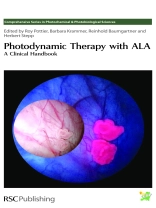Photodynamic therapy (PDT) is increasingly being used amongst health practitioners in combating a variety of diseases. One common strategy used during this light activated process is to induce the accumulation of significant amounts of a photosensitising agent in the diseased tissue. The naturally occurring amino acid 5-aminovulinic acid (ALA) is used to produce high levels of the photosensitizer, Protoprophyin IX, in the therapy known as ALA-PDT. Written by experts in the field Photodynamic therapy with ALA outlines a variety of clinical approaches to the topic, outlining current applications. These include the use of ALA-PDT and ALA-FD (fluorescence diagnosis) in the areas of dermatology, urology, brain, otorhinolaryngology, gynaecology and gastroenterology. Also included is a chapter that comprehensively reviews the scientific principles of ALA-PDT. Primarily aimed at a clinical audience Photodynamic therapy with ALA should provide a comprehensive review and useful insight into ALA-PDT.
Table des matières
INTRODUCTION;
Basic Principles;
ALA/MAL-PDT in Dermatology;
ALA-PDT and ALA-FD in Urology;
ALA-PDT and ALA-FD in the brain – new prospects for treating malignant gliomas;
ALA-FD AND ALA-PDT in Otorhinolaryngology;
ALA-PDT in Gynaecology;
ALA-PDT in Gastroenterology;
POTENTIAL FUTURE INDICATIONS;
APPENDIX












